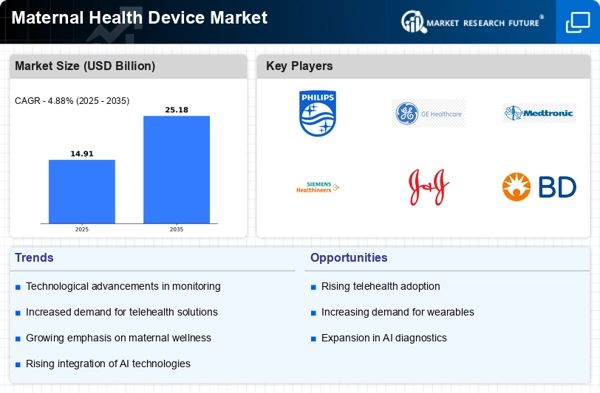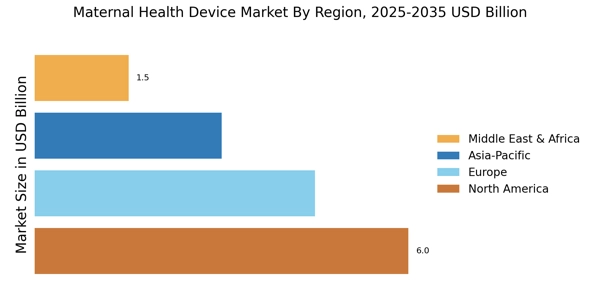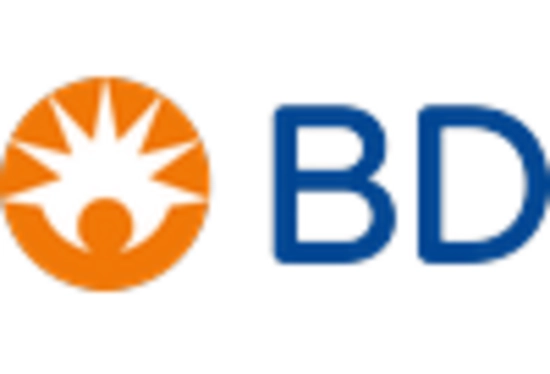Growing Emphasis on Maternal Health Education
The Maternal Health Device Market is increasingly influenced by a growing emphasis on maternal health education. As awareness of maternal health issues rises, there is a corresponding demand for devices that provide educational resources and support. Educational initiatives are being integrated into maternal health devices, offering users information on prenatal care, nutrition, and potential complications. This trend is supported by studies indicating that informed mothers are more likely to utilize health services effectively, thereby improving outcomes. The market for educational maternal health devices is projected to grow significantly, as stakeholders recognize the value of empowering women with knowledge. Consequently, this focus on education is likely to enhance the overall effectiveness of maternal health interventions.
Rising Demand for Remote Monitoring Solutions
The Maternal Health Device Market is witnessing a rising demand for remote monitoring solutions, driven by the need for accessible healthcare. As more women seek to manage their health from home, devices that enable remote monitoring of vital signs and fetal health are gaining traction. Reports suggest that the market for remote monitoring devices is expected to reach USD 2 billion by 2026, reflecting a growing preference for convenience and safety. This shift is particularly relevant in regions where access to healthcare facilities is limited. Remote monitoring not only enhances patient engagement but also allows healthcare providers to intervene promptly when necessary. Consequently, the proliferation of these solutions is likely to reshape the landscape of maternal health care, making it more efficient and responsive.
Increased Investment in Maternal Health Initiatives
The Maternal Health Device Market is benefiting from increased investment in maternal health initiatives by both public and private sectors. Governments and organizations are recognizing the critical importance of maternal health, leading to funding for innovative devices and programs aimed at improving outcomes. For instance, initiatives focused on reducing maternal mortality rates have prompted the development of advanced monitoring devices that can detect complications early. Data indicates that investments in maternal health technologies are expected to exceed USD 1.5 billion by 2025, highlighting a commitment to enhancing maternal care. This influx of capital not only fosters innovation but also encourages collaboration among stakeholders, ultimately driving the growth of the maternal health device market.
Regulatory Support for Maternal Health Technologies
The Maternal Health Device Market is experiencing favorable regulatory support, which is crucial for the development and adoption of new technologies. Regulatory bodies are increasingly recognizing the importance of maternal health devices and are streamlining approval processes to facilitate innovation. This support is evident in the expedited pathways for devices that demonstrate potential to improve maternal outcomes. As a result, manufacturers are more inclined to invest in research and development, knowing that their products will have a clearer route to market. Data suggests that regulatory approvals for maternal health devices have increased by over 30% in recent years, indicating a supportive environment for innovation. This trend is likely to accelerate the introduction of advanced maternal health technologies, ultimately benefiting women and healthcare providers alike.
Technological Innovations in Maternal Health Devices
The Maternal Health Device Market is experiencing a surge in technological innovations that enhance maternal care. Devices such as wearable monitors and telehealth solutions are becoming increasingly prevalent, allowing for real-time monitoring of maternal health indicators. This trend is supported by data indicating that the maternal health device market is projected to grow at a compound annual growth rate of approximately 8.5% over the next five years. These advancements not only improve the quality of care but also empower women by providing them with tools to manage their health proactively. Furthermore, the integration of artificial intelligence in these devices is likely to facilitate personalized care, thereby addressing individual health needs more effectively. As technology continues to evolve, the potential for improved maternal outcomes appears promising.


















Leave a Comment